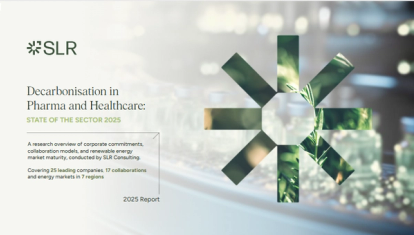
Decarbonising healthcare: Where to focus in the middle-market
- Post Date
- 23 September 2025
- Read Time
- 12 minutes

The healthcare sector accounts for an estimated 4–5% of global greenhouse gas (GHG) emissions. The industry is facing both external and internal pressures to reduce its carbon footprint and align its climate management practices to the broader mission of promoting societal health and wellness. Healthcare businesses have been feeling the regulatory and commercial pressures accelerate. In the UK, under NHS England’s Net Zero Supplier Roadmap, all suppliers will be required to publicly report emissions, emissions reduction targets, and reduction plans. In the US, major integrated healthcare systems, such as Kaiser Permanente, are embedding emissions tracking and reduction expectations into supplier contracts. Vizient, a large US healthcare group purchasing and performance organisation, has likewise incorporated environmental and social criteria into its procurement platform and helps suppliers report their carbon attributes. Similarly, regulations across the EU (e.g., CSRD, SFDR) are extending emissions and decarbonisation requirements deep into the healthcare sector through investor and corporate compliance obligations.
Middle-market healthcare companies face unique challenges in addressing these regulatory and commercial pressures towards decarbonisation. Unlike multinationals with dedicated sustainability resources, middle-market companies often operate with changing financial sponsors, leaner management capacity, and complex upstream supply chains (over which they have little control). Yet, ignoring decarbonisation is not an option. The industry perspective, as demonstrated by partnerships like Alliance to Zero, is that decarbonisation directly supports risk mitigation (regulatory, reputational, supply chain), commercial resilience (winning and complying with contracts), and product enhancement. Research by SLR found that leading pharma companies had set Scope 1 and 2 GHG reduction targets, and increasingly, Scope 3 targets as well (which covers upstream and downstream emissions). These priorities directly affect suppliers and are expected to cascade through value chains, imposing obligations on smaller players that are at risk of losing contracts, customers, and exit value for lagging on climate management and decarbonisation. Contrastingly, middle-market investors and management teams that view decarbonisation as a core business lever can position themselves to fasten and capture market share via these sectoral tailwinds.
While each middle-market healthcare company will have a decarbonisation journey that is specific to its operations, we outline how companies and investors can get started on managing emissions, and some of the common opportunities organisations can maximise as they approach scaling a decarbonisation strategy.
Foundational steps in your healthcare decarbonisation strategy
For the middle-market, the focus is on materiality and resource efficiency:
- Assess emissions hotspots: Identify which segments of the business emissions are concentrated in. For investors, these are companies with high GHG intensity relative to the rest of the portfolio. For management teams, these are high-emitting operational areas (e.g., freight, cold-storage, chemicals manufacturing).
- Inventory what matters most: Following a broad emissions audit, spotlight the specific products, relationships, and operational processes with the highest relative impact on the corporate emissions profile (e.g., the 10–20% of SKUs or supplier relationships accounting for 70–80% of emissions exposure).
- Map materiality to business value: Evaluate the business case for decarbonisation by comparing the future costs of externalities (e.g., contract value at risk, regulatory non-compliance) with the current costs of implementing decarbonisation controls. Potential value creation benefits from decarbonisation projects (e.g., energy cost savings) can be amortised over the proposed implementation period.
- Integrate into value-creation planning: Over the hold period, investors can leverage their influence over middle-market companies to push for decarbonisation initiatives that result in tangible value creation outcomes, such as procurement / operational savings, product differentiation, and customer growth / retention.
Role of standardisation and partnerships
One of the biggest challenges for PE-backed and middle-market healthcare companies is proving to external buyers that their decarbonisation progress is credible, comparable, and durable. Standardisation internally (across a portfolio) and externally (through industry partnerships) provides that assurance.
When buyers evaluate a middle-market healthcare company during exit diligence, they compare how that company’s ESG and sustainability profile stacks up against competitors. If portfolio companies measure emissions differently, report on different boundaries, or lack validation, the result is scrutiny and discounting.
A standardised framework for measuring decarbonisation progress ensures:
- Consistency: Scope boundaries, emissions factors, and reporting cadence are aligned. Buyers can quickly compare portfolio companies without questioning methodologies.
- Credibility: Framework-aligned approaches to emissions planning and decarbonisation (e.g., GHG Protocol, SBTi, ISO-certified tools like Sanofi’s EDDi system) make external diligence smoother.
- Efficiency: Shared templates, dashboards, and data management protocols reduce administrative burden for lean management teams, freeing them to focus on execution.
- Valuation uplift: A portfolio that demonstrates uniform, defensible reporting is easier to market to buyers who increasingly view ESG maturity as a proxy for operational discipline.
For investors, this means embedding decarbonisation requirements and common KPIs into operating models early, such that every portfolio company reports into a comparable framework. This creates a throughline across the fund, ensuring both investors and buyers can seamlessly evaluate progress without methodological caveats.
Coalition-building as a force multiplier
Middle-market companies cannot solve methodological fragmentation or supplier engagement burdens alone. Coalitions and consortia can create borrowing of scale and influence over markets.
- Reducing supplier fatigue: Industry coalitions (e.g., PSCI, TfS, EcoVadis Responsible Health Initiative) are already working to streamline supplier reporting and, in the case of PSCI and TfS, create efficiencies by reducing duplicative audits through shared audit programs. By joining these, middle-market companies avoid creating duplicative requests and instead plug into a standard. This saves time and codifies best practices.
- Access to renewable energy: Programs like Energize pool demand from multiple pharma players to negotiate PPAs and vPPAs that suppliers could never access alone. This model democratises renewable access for middle-market energy consumers in the healthcare sector.
- Methodological convergence: Initiatives such as Pharma LCA, BioPhorum, and Alliance to Zero are actively harmonising LCA methodologies. For the middle-market, alignment with these groups avoids sunk costs in proprietary methods that could later be deemed non-compliant.
- External credibility: Partnerships with high-profile entities (e.g., NHS Net Zero supplier programs, Energize, PSCI) can demonstrate and effect program maturity. Investors, regulators, and other stakeholders increasingly ask not only “what have you done?” but “who have you partnered with?”.
For middle-market investors, coalition-building magnifies the impact of portfolio-level action. By engaging portfolio companies in shared platforms, investors reduce execution costs, align with global best practices, and grow cohesion across holdings. In effect, standardisation and coalition-building convert decarbonisation from a scattered compliance exercise into a scalable, defensible, and value-creating strategy for healthcare investors.
What investors can do now
The role of middle-market PE sponsors investing in the healthcare sector goes beyond year-over-year monitoring of portfolio emissions. Decarbonising healthcare assets has become central to the long-term success of the businesses. Walking portfolio companies through the hurdles of a decarbonisation roadmap should be a facet of the investment thesis.
Practical steps include:
- Develop a climate roadmap at the fund level:
- A fund-level roadmap should define the end-to-end processes, from investment to exit, to be executed at the asset-level for successful alignment to a net zero pathway
- Limited Partners are increasingly requesting documented strategies for fund-level decarbonisation and clear processes / mechanisms to deliver reductions
- If successfully implemented during the hold period, decarbonisation roadmaps signal to prospective buyers at exit that sustainability and long-term value creation has been embedded
- Integrate emissions reduction targets into ESG + operational KPIs: Aim to align decarbonisation goals with margin improvement, procurement, and growth KPIs from acquisition through exit.
- Engage experts early in the investment process: Consult technical advisors to identify value-creating decarbonisation opportunities that both reduce costs and lower emissions intensity (e.g., HVAC optimisation, heat pumps, heat recovery systems, supplier PPA facilitation, solvent recovery in labs). This ensures the fund’s overall emissions intensity decreases over the investment cycle.
- Position decarbonisation as commercial differentiation: Payers and providers are already favouring suppliers with credible carbon strategies. Framing decarbonisation as a revenue lever helps management teams embrace it as a growth driver. For example, in the UK waste sector, Viridor conducted climate change adaptation planning (CCAP) assessments across all 23 of its waste sites to strengthen its commercial resilience, a move supported by investors such as KKR.
- Treat regulations as tailwinds, not threats: Research and monitor frameworks like CSRD, NHS Net Zero, and emerging US climate disclosure rules. Such frameworks could evolve into the ‘common language’ of decarbonisation in the industry. Early adoption of the leading frameworks keeps companies agile and prepared for changes to regulatory or contractual reporting obligations.
What to prioritise: high-impact levers
1. Supplier engagement
In the US, Scope 3 emissions (value chain) typically account for 70–90% of a healthcare facility’s footprint. Accordingly, supplier engagement could be the single most impactful decarbonisation lever in the sector. Actions smaller companies can take include:
- Issuing supplier codes of conduct with emissions disclosure requirements
- Using collaborative platforms (e.g., PSCI’s Environmental Survey, EcoVadis Responsible Health Initiative) to reduce reporting fatigue
- Where possible, pooling supplier engagement across portfolio companies to create economies of scale
Nearly all major pharma players now require suppliers to set SBTi-aligned targets. Yet suppliers report a “bureaucratic maze” of duplicative requests. Smaller companies that streamline and align with industry collaboratives could find themselves viewed as foundational partners rather than burdens, improving supplier responsiveness and loyalty.
2. Transition to renewable energy
Energy is often the most visible and quantifiable emissions lever. Middle-market companies can focus on:
- Creating a decarbonisation roadmap for their own operations aligned with operational and financial goals by combining best-fit solutions (such as energy management, electrification, renewable electricity, green gas)
- Exploring pooled PPAs and vPPAs through programs like Energize, which leverage collective pharma demand
- Using “energy-as-a-service” or on-bill repayment structures to reduce upfront capital requirements for decarbonisation assets
Regional maturity varies significantly – Europe, the UK, and the US have seen progress, while renewable infrastructure in China and parts of LATAM remain nascent. Investors should calibrate expectations accordingly, supporting suppliers on creative solutions where local renewable access is constrained.
3. Life Cycle Assessment (LCA) readiness
LCAs are increasingly required for pharma supplier contracts and product approvals, making early capability building essential. Seventeen of the 25 major pharma companies in SLR's State of the Sector research report use LCAs, but methodologies remain fragmented. Collaboratives like Pharma LCA, BioPhorum, and Alliance to Zero are racing to harmonise frameworks. Middle-market players can future-proof by aligning with these emerging standards early, rather than investing in proprietary approaches that may be invalidated later.
Conclusion
Decarbonisation has become a commercial and strategic necessity for the healthcare sector. For middle-market companies, the primary challenge remains resource intensity, but their advantage is agility. By leveraging a network of subject matter experts for supplier engagement, renewable energy sourcing, and process standardisation, middle-market investors can equip portfolio companies with the resources needed to punch above their weight in building climate plans.
Codifying decarbonisation strategies into fund-level roadmaps, embedding emissions into value-creation planning, and engaging experts during the hold period are no longer fringe activities. They are critical to lowering the emissions of healthcare-focused funds, meeting stakeholder expectations, and ultimately creating more valuable, resilient companies.

This article was produced by:
Brian Fox - Head of Carbon and Climate Solutions, Malk Partners, part of SLR
Daniel Witte - Associate Director, Corporate Sustainability Advisory, SLR
Peter Ekmans - SVP, ESG Value Creation, Malk Partners, part of SLR
Rosie Towe - Director, Corporate Sustainability Advisory, SLR
Stéphane Rapoport - Head of energy and emissions excellence, SLR
To speak to one of our experts, please get in touch.
Contact SLR
